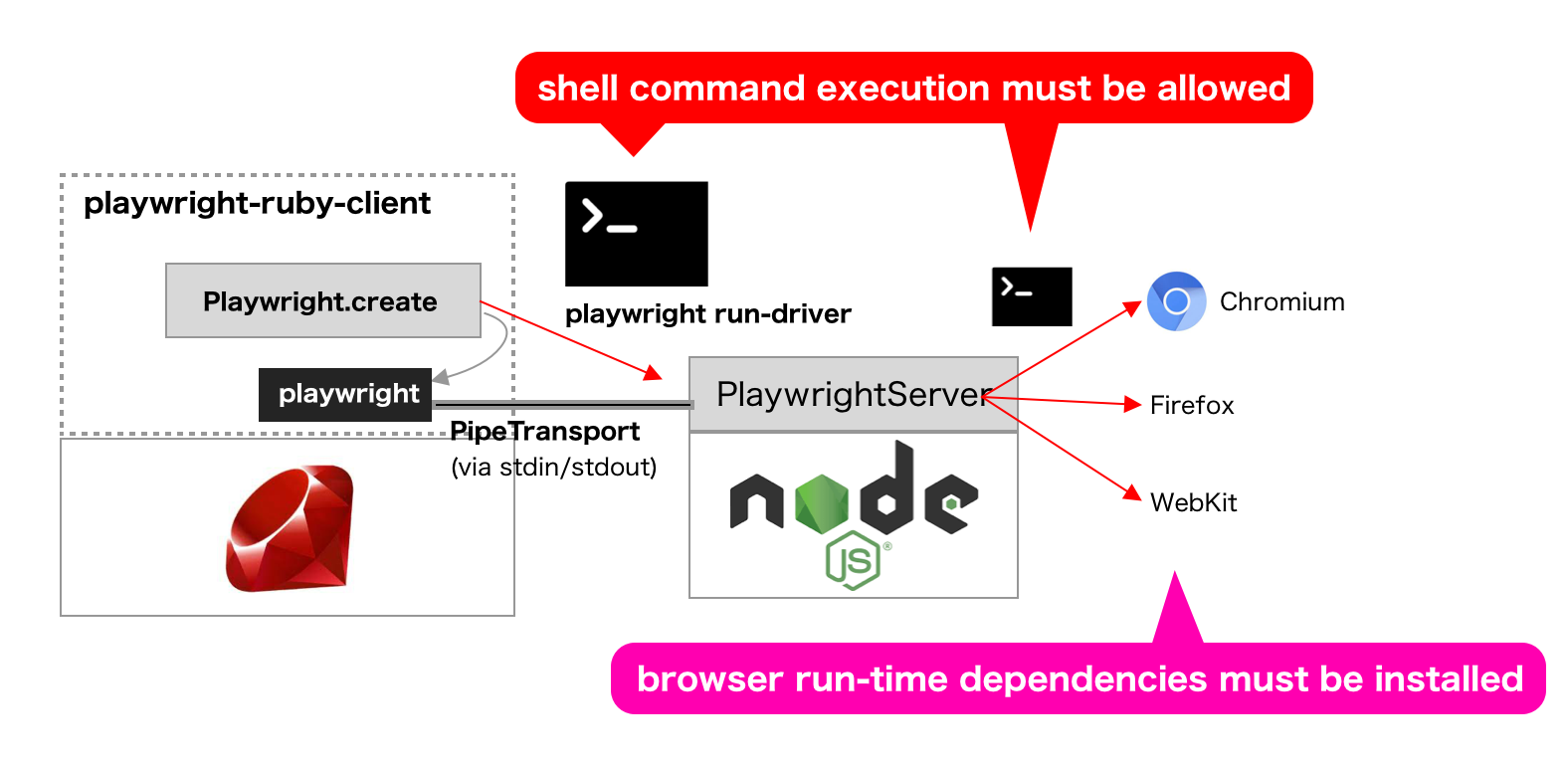Playwright on Alpine Linux
NOTE: This feature is EXPERIMENTAL.
Playwright actually requires a permission for shell command execution, and many run-time dependencies for each browser.

This all-in-one architecture is reasonable for browser automation in our own computers.
However we may have trouble with bringing Playwright into:
- Docker
- Alpine Linux
- Serverless computing
- AWS Lambda
- Google Cloud Functions
- PaaS
- Heroku
- Google App Engine
This article introduces a way to separate environments into client (for executing Playwright script) and server (for working with browsers). The main use-case assumes Docker (using Alpine Linux), however the way can be applied also into other use-cases.
Overview
Playwright Ruby client is running on Alpine Linux. It just sends/receives JSON messages of Playwright-protocol via WebSocket.
Playwright server is running on a container of official Docker image. It just operates browsers in response to the JSON messages from WebSocket.

Playwright Server v.s. Browser Server
Playwright provides two kind of methods to share the browser environments for clients.
When you want to share only one browser environment, Browser server is suitable. This feature is officially supported in Playwright.
- Server can be launched with BrowserType#launchServer instead of
BrowserType#launch. - Client can connect to server with BrowserType#connect. In playwright-ruby-client,
BrowserType#connectand not implemented yet and usePlaywright#connect_to_browser_server()instead.
Another method is sharing all browser environment. This method is very simple, but not an official feature, and can be changed in future.
- Server can be launched with
playwright run-server(CLI command). - Client can connect to server with
Playwright.connect_to_playwright_serverinstead ofPlaywright.create
Playwright server/client
Client code
Many example uses Playwright#create, which internally uses Pipe (stdin/stdout) transport for Playwright-protocol messaging. Instead, just use Playwright#connect_to_playwright_server(endpoint) for WebSocket transport.
require 'playwright'
Playwright.connect_to_playwright_server('wss://example.com:8888/ws') do |playwright|
playwright.chromium.launch do |browser|
page = browser.new_page
page.goto('https://github.com/microsoft/playwright')
page.screenshot(path: 'github-microsoft-playwright.png')
end
end
wss://example.com:8888/ws is an example of endpoint URL of the Playwright server. In local development environment, it is typically "ws://127.0.0.1:#{port}/ws".
Server code
With the official Docker image or in the local development environment with Node.js, just execute npx playwright install && npx playwright run-server --port $PORT --path /ws. ($PORT is a port number of the server)
If custom Docker image is preferred, build it as follows:
FROM mcr.microsoft.com/playwright:focal
WORKDIR /root
RUN npm install playwright@1.12.3 && ./node_modules/.bin/playwright install
ENV PORT 8888
CMD ["./node_modules/.bin/playwright", "run-server", "--port", "$PORT", "--path", "/ws"]
Browser server/client
Client code
Use Playwright#connect_to_playwright_server and pass the WebSocket URL for browser server.
Note that this method requires a block with Browser, not Playwright or BrowserType.
Playwright.connect_to_playwright_server(ws_url) do |browser|
page = browser.new_page
page.goto(...)
...
end
Server code
For instant use, npx playwright launch-server --browser chromium generates a WebSocket endpoint URL with a random path.
More customization can be done by implementing JavaScript server like below:
const playwright = require('playwright')
option = {
channel: 'chrome-canary',
headless: false,
port: 8080,
wsPath: 'ws',
}
playwright.chromium.launchServer(option).then((server) => { console.log(server.wsEndpoint()) })
port and wsPath would be useful for generating static WebSocket endpoint URL.
Other available options for BrowserType#launchServer can be found here:
https://playwright.dev/docs/api/class-browsertype#browser-type-launch-server
Debugging for connection
The client and server are really quiet. This chapter shows how to check if the communication on the WebSocket works well or not.
Show JSON message on client
Just set an environment variable DEBUG=1.
DEBUG=1 bundle exec ruby some-automation-with-playwright.rb
Enable verbose logging on server
Just set an environment variable DEBUG=pw:* or DEBUG=pw:server
DEBUG=pw:* npx playwright run-server --port 8888 --path /ws
See the official documentation for details.